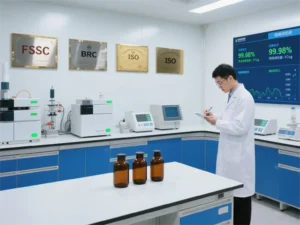Basic Chemicals: What is the Main Use of Formic Acid?
Among the large portfolio of basic chemicals, formic acid emerges as one of the most versatile and widely used organic acids. Chemically known as HCOOH or methanoic acid, it is the simplest carboxylic acid. Its applications cover a wide range of industries, from agriculture to energy. The name “formic” comes from the Latin word for ant, because it was first discovered in ants. Modern formic acid producers around the world manufacture this critical chemical on a mass scale, making it available for a highly diverse set of industrial, medical, and environmental applications. Its versatility and widespread availability make it a staple for many companies seeking reliable and cost-effective chemical solutions.
Formic acid is a colorless liquid with a pungent smell, highly soluble in water, and highly reactive due to its acidic and reducing properties. It is considered one of the essential building blocks of chemical manufacturing and a key part of the basic chemicals toolkit that supports modern industry. Its relatively simple molecular structure allows for modifications and applications in multiple chemical reactions, making it indispensable in modern chemical engineering.
History of Formic Acid
The history of formic acid stretches back centuries. Early naturalists observed that crushed ants released a chemical with a strong, acidic smell. By the 1600s, chemists had successfully isolated this compound and confirmed its chemical structure. Over the years, production methods have shifted from natural extraction from ants to industrial chemical synthesis, significantly increasing yield and lowering costs. These historical developments demonstrate how basic natural observations evolved into large-scale industrial processes, highlighting the adaptability and economic significance of formic acid.
Today, manufacturers of formic acid employ advanced production techniques to meet industrial demand. Significant global producers include BASF, Eastman Chemical Company, Feicheng Acid Chemicals, and many Chinese manufacturers. Collectively, they supply millions of tons of formic acid each year. These producers continually innovate, improving energy efficiency and environmental compliance, reflecting the growing importance of sustainability in chemical production.
Industrial Production Methods
Carbon Monoxide and Sodium Hydroxide Method
A major industrial process involves reacting carbon monoxide with sodium hydroxide to form sodium formate under high pressure and temperature:
CO+NaOH→HCOONaCO + NaOH \rightarrow HCOONaCO+NaOH→HCOONa
The sodium formate is then acidified with sulfuric acid to produce pure formic acid. This method is highly efficient and widely adopted in chemical plants around the world. Due to its scalability and consistency, it remains one of the most preferred methods for large-scale formic acid production.
Methyl Formate Hydrolysis
Another common method involves reacting methanol with carbon monoxide in the presence of a catalyst to form methyl formate, which is then hydrolyzed to yield formic acid and methanol. This route is preferred for environmentally conscious production due to lower energy requirements and fewer byproducts. Additionally, this method allows producers to adjust reaction parameters for higher purity outputs, which is particularly important for sensitive applications such as pharmaceuticals.
Green Production Techniques
Modern formic acid producers are exploring greener alternatives, such as electrochemical and biomass-based synthesis. These methods aim to reduce carbon emissions, improve energy efficiency, and support sustainable chemical manufacturing. Research in this area also explores renewable feedstocks and lower water consumption, helping industries transition toward environmentally responsible production practices.

Physical and Chemical Properties
-
Molecular Weight: 46.03 g/mol
-
Density: 1.22 g/cm³
-
Boiling Point: 100.8°C
-
Solubility: Miscible with water and most polar solvents
Formic acid acts as both a strong acid and a mild reducing agent. It is also volatile and must be handled carefully, especially in concentrated forms. Its reactivity makes it ideal for many synthetic processes while also requiring strict adherence to safety protocols.
Major Uses of Formic Acid
Formic acid finds multiple applications in the basic chemicals sector. Its primary uses include:
1. Agriculture
a. Animal Feed Preservation
Formic acid acts as a preservative in livestock feed. Its acidity inhibits bacterial growth, including harmful species like Escherichia coli, maintaining feed quality and animal health. Treated feed has a longer shelf life, benefiting both farmers and producers. Its use in feed stabilization ensures economic efficiency for large-scale animal farms.
b. Silage Production
In silage production, formic acid promotes lactic acid fermentation while preventing the development of butyric acid, ensuring high-quality, nutrient-rich feed for livestock. The controlled fermentation process improves digestibility and nutrient availability for animals.
c. Beekeeping and Hive Health
Formic acid is regularly used to control parasitic mites in bee colonies, such as Varroa mites, without contaminating honey. This provides a safe and effective method for maintaining hive health. Beekeepers rely on this method for sustainable honey production, as it balances pest control and product safety.
2. Industrial Applications
a. Leather Tanning and Textile Processing
In leather production, formic acid assists in hair removal and pH adjustment during tanning, improving texture and quality. In textiles, it stabilizes dyes and enhances color retention for natural fibers like wool and silk. This dual functionality demonstrates the value of formic acid across related industries.
b. Rubber Industry
Formic acid acts as a coagulating agent in rubber latex production, ensuring efficient and uniform rubber processing. Its use improves product consistency, critical for automotive and industrial applications.
c. Cleaning and Disinfection
Formic acid is used as a descaling agent to remove mineral deposits and limescale from equipment, pipelines, and domestic appliances. Its antimicrobial properties also make it suitable for disinfectant formulations. Industrial cleaners rely on formic acid for cost-effective maintenance and hygiene compliance.
d. Chemical Synthesis
Formic acid serves as an intermediate for:
-
Formate esters are used in fragrances and solvents
-
Reducing agent for organic synthesis
-
Fine chemicals and pharmaceuticals
It is a versatile reagent in contemporary chemical manufacturing, enabling a wide variety of chemical reactions.
3. Pharmaceutical and Medical Uses
Formic acid is used in the synthesis of pharmaceuticals, including intermediates for antibiotics and other medications. Its keratolytic properties allow for topical applications, such as treating warts and minor skin conditions. Its controlled use in dermatology highlights the safe and effective applications of this chemical beyond industrial processes.
4. Energy and Environmental Applications
a. Hydrogen Storage
Formic acid is an emerging hydrogen carrier. Controlled decomposition releases hydrogen gas, offering a high-density, safe hydrogen source for fuel cells. This innovative application shows its potential in renewable energy technologies.
b. Fuel Cells
Direct formic acid fuel cells (DFAFCs) use liquid formic acid as fuel. They are suitable for small electronic devices, portable power systems, and potentially automotive applications due to safety and energy density. Research is ongoing to optimize fuel efficiency and reduce operational costs.
c. Environmental Cleaning
Biodegradable and strongly acidic, formic acid is applied in eco-friendly cleaning processes and water treatment. Its use in green chemistry supports the reduction of chemical waste and promotes sustainable industrial practices.
5. Other Applications
- Food preservation (limited, regulated use)
- Laboratory reagents in analytical chemistry
- pH adjustment in the leather and photographic industries
Formic acid’s multifunctionality makes it one of the most demanded basic chemicals globally.
Safety and Regulatory Considerations
Formic acid is corrosive and can cause burns upon skin or eye contact. Safety measures include:
-
Wearing personal protective equipment (gloves, goggles)
-
Ensuring proper ventilation during handling
-
Storing in corrosion-resistant containers
Regulatory bodies such as OSHA, REACH, and local authorities supervise its handling, storage, and transportation to ensure industrial safety. Proper training and awareness programs are critical for industrial workers handling this chemical.

Global Market and Economic Significance
The global formic acid market continues to grow due to its increasing use in agriculture, textiles, and energy. Major producers, including BASF, Eastman Chemical, and Feicheng Acid Chemicals, dominate the market. China remains the largest producer, serving both domestic and international demand. Market growth is influenced by raw material availability, energy costs, and sustainable production technologies. Rising interest in green chemicals and hydrogen applications is expected to further accelerate global demand.
Future Trends
Formic acid demand is expected to rise in the coming decades due to:
-
Expansion of hydrogen energy technologies
-
Growth of eco-friendly agriculture
-
Development of green chemical synthesis methods
-
Rising need for industrial cleaning and disinfection
Formic acid producers prioritize sustainability, efficiency, and customization to meet global industry needs. Research and innovation in production methods will likely reduce costs, improve purity, and expand applications even further.
Formic acid is a cornerstone of basic chemicals with extensive applications in agriculture, industry, pharmaceuticals, and energy. It acts simultaneously as a preservative, reducing agent, chemical intermediate, and fuel, demonstrating its versatility and importance.
From feed preservation to hydrogen storage, its wide range of uses highlights why formic acid remains essential for manufacturers, chemists, and innovators worldwide. Understanding its production, properties, applications, and safety guidelines allows industries to maximize its potential, cementing its position as a truly multi-purpose chemical in the basic chemicals portfolio. Its adaptability, sustainability, and functionality make it indispensable in modern industrial processes.



